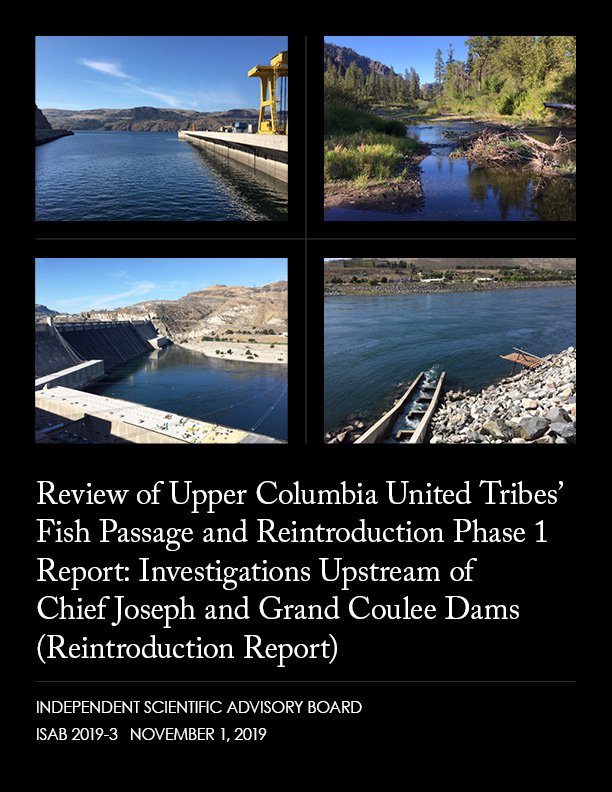Science Board, Citing Uncertainties, Says Salmon Reintroduction Above Grand Coulee 'Could Be Successful'
- November 15, 2019
- John Harrison

A board of 11 independent scientists says it is reasonable to expect that reintroduction of salmon and steelhead above Chief Joseph and Grand Coulee dams, “could be successful to some extent.” But, the scientists warn, “there is great uncertainty about the numbers of adults that will return and the types of management that will be required to maintain them.” The two dams have blocked anadromous fish passage to the upper Columbia since the late 1930s (Grand Coulee) and the mid 1950s (Chief Joseph).
Therefore, the Independent Scientific Advisory Board encouraged the Upper Columbia United Tribes, which produced the report, and the Council, which asked for it, to “make decisions conservatively or with caution because of the very wide ranges of estimates of capacity and habitat availability.”
In presenting the ISAB’s review to the Council this month, ISAB Chair Stan Gregory, a retired Oregon State University fisheries professor, complimented the UCUT tribes for the report, noting that there were “no fatal flaws” and that it is scientifically credible. “The tribes and their collaborators put an awful lot of thought into preparing this report, and as a result it is very accessible to others” Gregory said.
The UCUT tribes submitted their report to the Council in June, and the next month the Council asked the ISAB to review it. ISAB members are appointed jointly by the Council, NOAA Fisheries, and the Columbia River Inter-Tribal Fish Commission from a list of nominees provided by the National Academy of Sciences.
The tribes prepared the report in response to direction in the Council’s 2014 Columbia River Basin Fish and Wildlife Program that calls for a three-phase strategy to investigate the feasibility of reintroduction. The UCUT report partially addresses Phase One of the strategy.
The Council asked the ISAB to answer a set of questions about the strengths, data uncertainties, and limitations of each element of the UCUT’s report, including:
- Donor stocks: The ISAB said the process and recommendations for likely stocks to reintroduce are scientifically credible, primarily the choice of upper Columbia summer/fall Chinook, plus sockeye from the Okanagan River and possibly kokanee from Lake Roosevelt, which could be released to see if they go to the ocean and return.
- Disease risks : Future assessments of disease risk should consider possible interactions between water quality, disease resistance, and other factors such as predator avoidance. The ISAB advocates development of a parentage-based tagging (PBT) program for all adults released in the blocked area to identify donors with the greatest disease resistance and to assess other factors that influence the success of reintroduction.
- Predation risks: The report concluded that predation risk to juveniles produced by reintroduced salmon probably will be high overall but variable, depending on how they overlap in areas where predators are present.
- Habitat: The report’s habitat assessments identified both current available habitat within the blocked area as well as habitat that could be restored. The assessments “provided a reasonable set of hypotheses about the capacity of the habitat in the blocked area to support juvenile and adult salmonids,” according to the ISAB review. There is much uncertainty, though, about the capacity of the habitat to produce Chinook and sockeye, and also about the future impacts of climate change in the habitat, the river, and the ocean, which the ISAB commended the UCUT report for considering.
- Fish passage at Grand Coulee and Chief Joseph: The ISAB said the proposed interim adult-fish passage approaches appear to be reasonable. However, fluctuations of reservoir levels would make passage for both life stages, juvenile and adult, difficult.
- Costs: The reintroduction report did not assess the costs of upstream and downstream passage options for salmon and steelhead. Because specific donor stocks and passage systems have not been selected, only broad preliminary estimates of cost could be developed currently. Decisions about donor stocks and cost estimates of passage alternatives should be done sooner than later, the ISAB recommended.
Council members thanked the ISAB for its review and the UCUT tribes for the report.
Washington Council Member Guy Norman, commenting that “this issue has been front and center for the Council and tribes for a number of years,” asked Gregory how reintroduced salmon might best be sustained, invoking the example of Snake River fall Chinook, a species that has rebounded through the use of hatchery-reared fish to supplement natural production. The example of the Snake is appropriate, Gregory said, adding that “the tribes probably will have to proceed along those lines using hatchery fish for reintroduction” if the decision is made to take the next steps in the reintroduction strategy. Modeling will help better understand uncertainties around habitat, fish production, and impacts such as harvest, which he said he was shocked to learn has been as high as 80 percent of adult upriver Chinook.
Council Vice Chair Richard Devlin, an Oregon member, noted there are many issues to address regarding reintroduction, and that “these should be approached cautiously and in an incremental manner.”



